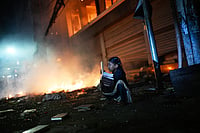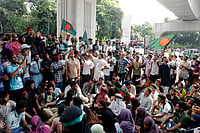WHEN the May-June session of the CTBT negotiations closed, even the Indian press had to register New Delhi's isolation and the unexpected angry outbursts from Russia and the UK. Ironically, the US, long painted as the primary villain, calmly received India's decision not to sign the treaty, and sensibly, didn't insist that the treaty's 'entry into force' be contingent on India's signature.
The CTBT is too valuable to be held a hostage in this way. Its completion will decisively weaken the technological push fuelling the arms race. It will break the 'talk-test-build' format that was the bane of arms control during the Cold War. It will weaken the 'fear factor' (fear of new advances by the adversary) that drove the arms race. It will prevent production of ever-deadlier new generation weapons and vastly improve the climate for further restraint and disarmament measures, e.g. fissile materials cut-off, no-first use, freeze on production of, and class-by-class destruction of, nuclear weapons. It will psychologically devalue the ugly mystique surrounding nuclear weapons.
The careful reader of the Indian press, fed for two years on a self-righteous and sanctimonious diet of how worthless the CTBT is, how Machiavellian and duplicitous the nuclear weapons-states (NWSs) are, and how honourable India's stand has been, might now wonder if the issue is not a lot more complicated and if India has not been a spoiler after all.
Once the heart of the treaty—its scope (prohibiting explosive testing of any yield)—was agreed upon, all the major players (US, Russia, China, France, UK, Israel and Pakistan) showed willingness to make significant concessions, whether on preamble or verification, in order to get a good consensual treaty. There were two demands which could never have been accepted without destroying the purpose and possibility of a CTBT. Since there is no technological difference between a peaceful nuclear explosion (PNE) and a military one, PNEs had to be excluded. Ultimately, China more or less gave way on this.
The other unacceptable demand was India's insistence on a structural link between the CTBT and 'time-bound' disarmament. Situating the CTBT in a disarmament context and therefore stressing strong preambular references to it was widely supported. But holding the treaty hostage to the reluctance of the NWSs to immediately commit themselves to a specific time-schedule for total disarmament (will India accept a fixed time-schedule for solving the Kashmir issue permanently?) was unjustified and isolated India.
Had this been a bargaining counter, India could have leveraged for improving an already good draft, but not once was it perceived as intransigent. When it became the first and only country to declare it would not sign even before Jaap Ramaker tabled his final text, India showed a special contempt for the CTBT negotiations and bad faith towards its own tradition of pioneering and campaigning for a CTBT. There was widespread anger at India even among the Non-Aligned G-21 because in the critical last fortnight, New Delhi spurned their invitation to harmonise a joint draft and said it would talk only to the five NWSs.
New Delhi revealed the real reasons for opposing a CTBT when it declared on June 20 that the treaty does not address India's security needs. This was an illegitimate shift from its earlier reservation on scope and linkage, couched in 'universal' and 'global', not 'national security' language. However, a CTBT is not meant to address differing country-wise security needs. Doing so would destroy its very purpose and meaning which is to be universal and impartial in its impact. That is the criterion by which it is to be judged. In this respect, for all the ill-informed talk about the CTBT's technical inefficacy (see our book, Testing Times) the real stumbling block has been India's misperception of 'national security'.
Our policy-makers' main fear is that by capping our weapons capability, a CTBT will leave India regionally insecure. This is misplaced. A CTBT will freeze Pakistan and China on the learning curve, leaving relative country positions unchanged. Surely, it is in our interest that China and other NWSs—and Pakistan—do not develop even more sophisticated weapons. Besides, development of missiles and at least first-generation nuclear weapons can continue unhindered without nuclear tests. Thus, even hawks like Gen. Sundarji admit, India can have an effective 'minimum deterrent' against China (with 100 warheads) despite signing a CTBT. But our policy-makers want to keep all options—including full-scale explosive testing—indefinitely open although they accuse others of being insincere about banning tests. The basic problem is that their stand on the CTBT is of a piece with India's generally incoherent nuclear posture.
New Delhi cites the Pakistan threat but has never agreed, nor responded, to Islamabad's proposals to denuclearise South Asia. It cites the Chinese threat as a justification, but cannot engage in serious nuclear diplomacy with China because this is only possible if both sides see each other as threats. China doesn't see itself as a threat to India and vice versa. Though only the US tried (unsuccessfully) to nuclearly blackmail India in 1971, India never talks about the fact that it had no choice but to live with the American (and Russian) bomb and has done so comfortably. It has also lived comfortably with the Chinese bomb for 32 years but is obsessed with the utterly abstract possibility of threats even though China has never threatened anyone. The Chinese bomb didn't prevent Vietnam from giving it a bloody nose in 1979, nor conventional-military clashes with nuclear Russia on the Ussuri.
Nothing has happened in the recent past that qualitatively escalates the supposed Chinese and/or Pakistani threats. It is futile to cite ring magnet transfers: limited Sino-Pak nuclear cooperation is old. And lacunae in the Missile Technology Control Regime are no argument against a CTBT. Indeed, since the end of the Cold War, a hesitant, uneven but nonetheless new and real momentum towards realisation and global disarmament has emerged. The imminent realisation of a CTBT itself reflects this. For the first time since the Nuclear Age began, there has been actual withdrawal and dismantling of thousands of US and Russian warheads and missiles, with the promise of more to come. Three NWSs—Belarus, Kazhakstan and, most importantly, Ukraine—have gone nonnuclear. Three formed threshold states—South Africa, Brazil, Argentina—have renounced their capability. Countries like Mexico are threatening to withdraw from the NPT if the NWSS don't accept nuclear restraint. Worldwide, there is growing public opinion favouring disarmament.
Yet, in the same period domestic temptations in India to go openly nuclear have dramatically increased! Could there be clearer evidence that New Delhi's nuclear anxieties have much less to do with regional or global threats than with grandiose self-perceptions and confused strategic thinking? Crossing the nuclear Rubicon will not increase, but decrease, regional security as Pakistan follows suit; China will systematically target India as a strategic adversary; both will explore stronger nuclear ties. The US, Russia, India's other neighbours and the Non-Aligned will turn hostile.
It is vital that New Delhi refuses to be stampeded by the current hysteria over the CTBT which threatens to spill over into a fatal and fateful decision from which there will be no turning back. By testing or going nuclear, India will definitely destroy the worldwide momentum of moderation and hope. So much for India's avowed commitment to promoting nuclear sanity. India should be a prominent part of this new momentum. It should seriously reenter the CTBT negotiations to bring them to successful conclusion and then seize the initiative for other nuclear restraint and disarmament measures. The only thing to do with these uniquely evil weapons of indiscriminate mass destruction is to eliminate them.
(Praful Bidwai and Achin Vanaik, columnists and scholars, co-authored Testing Times: the Global Stake in a Nuclear Test Ban, recently published by the Dag Hammarskjold Foundation, Sweden).


























